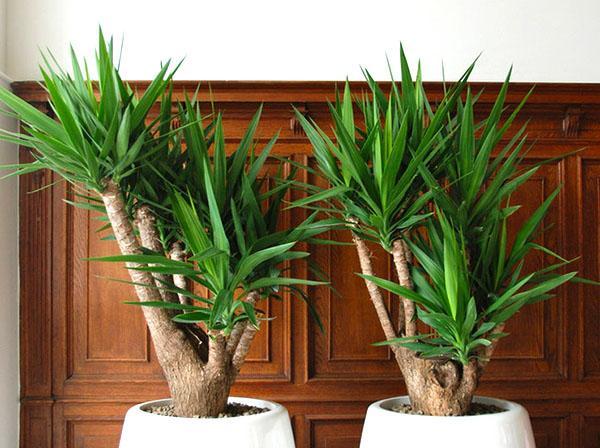Growing encyclopedia: elephant's yucca
 A thick, stiff pillar is crowned with a dense green rosette of leaves. It is thanks to such decorative features that the elephant yucca won the love of gardeners. It is also worth adding to this unpretentious character, which is accompanied by simple care of the culture. Most often it is grown for the sake of chic peduncles, which are covered with large drooping white bells.
A thick, stiff pillar is crowned with a dense green rosette of leaves. It is thanks to such decorative features that the elephant yucca won the love of gardeners. It is also worth adding to this unpretentious character, which is accompanied by simple care of the culture. Most often it is grown for the sake of chic peduncles, which are covered with large drooping white bells.
When planting a garden variety in a front garden, you do not need to think that it remains the same perennial flowerpot. In the fall, it is transplanted into a pot, brought into the house and stored in a cool place.
Yucca the elephant: from planting to dormancy
It cannot be attributed to super-whimsical cultures. Nevertheless, to enjoy the beauty of an exotic tree, it is worth understanding what it needs. A dormant period is observed in the life of a plant. It begins in the fall and continues until spring. The flowerpot transfers it more easily when it is in a cool room (15-16 ° C without hesitation). In this case, the lighting should be good. From October to February, the tree is moistened only three times. In warm and dry climates, watering is carried out once a month. Yucca elephant will need to prepare a loose, textured soil. The moisture-consuming substrate consists of:
- greenhouse land;
- a large portion of drainage material - tree bark;
- charcoal;
- moss sphagnum.
The rule of watering - the hotter, the more abundant moisture should be. Since the end of March, yucca has been fed every 10 days with complex mineral fertilizers.
The pot is selected small in size and filled with components that have been thoroughly mixed. As the container is filled with the substrate, shake the dishes so that cavities do not form in the soil.
A weak root system is a weak point of culture. She often suffers from overfills. This is one of the reasons why store-bought seedlings start to rot. So, when transplanting, the transport soil is shaken off from the rhizome.
In the summer, the flowerpot is taken out to the balcony or yard. Doing this is not strongly recommended, otherwise there will be sunburn. First, the culture is accustomed to weather conditions for 7 days, and then left for a short time in partial shade.
Specific reproduction
The plant is delivered to gardening farms in Europe from Honduras. There, experienced florists propagate it in a very clever way. The trunk is divided into fragments and then planted. After a while, buds wake up at the top point of each such cutting, which soon form rosettes. Bushes are cut from them, which serve as seedlings. Only such a shank is erected in a small greenhouse: a support is placed in the center of the pot and covered with a transparent bag. The green mass is sprayed periodically. As a result, it will take root faster. Such an operation with elephant yucca (but only with seven-year-old or tall trees) can be carried out at home.